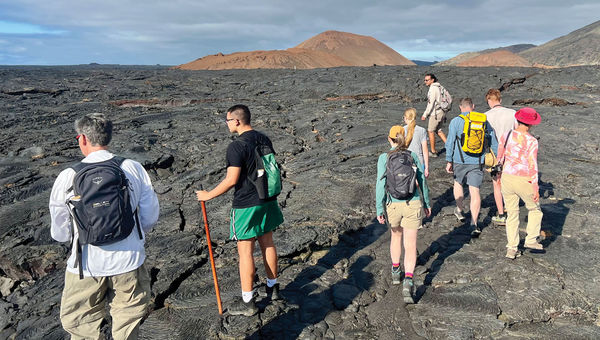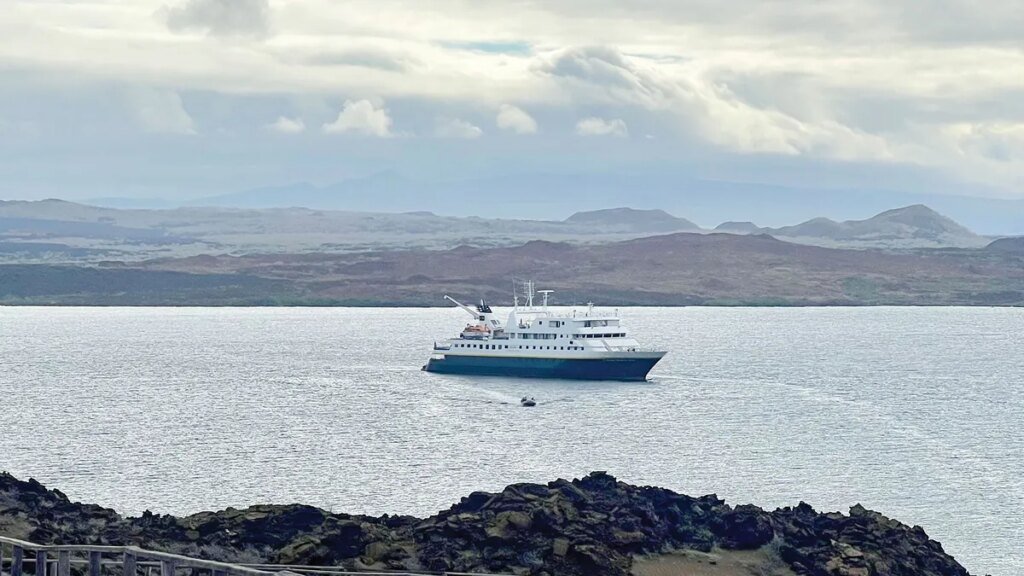“It’s a blue whale, the largest animal on the planet!” exclaimed the expedition leader, igniting a wave of excitement as passengers hurried to the front of the ship hoping to witness a majestic spout.
After the initial sighting, the captain turned the ship back for a second look as the whale gracefully surfaced multiple times before vanishing beneath the waves of the Bolivar Channel in the Galapagos Islands. While travelers to the Galapagos can anticipate encounters with myriad wildlife—such as giant tortoises, marine iguanas, and numerous endemic birds—the blue whale sighting was a thrilling bonus, reflected in the excited chatter among even the most seasoned crew members.
This journey took us through the enchanting Galapagos with National Geographic-Lindblad Expeditions to attend the official naming ceremony for two new additions to the fleet: the National Geographic Gemini and the National Geographic Delfina. Both ships, acquired last year, underwent extensive renovations and commenced operations in early 2025.
Sea lions bask on the beach with the National Geographic Gemini in the background. Photo Credit: Bart Beeson
The National Geographic Gemini and Delfina
Accommodations were provided on the 48-passenger Gemini, featuring 28 cabins, both indoor and outdoor dining areas, a whirlpool hot tub, spa, and fitness center. The luxury catamaran, Delfina, accommodates just 16 passengers, offering a more intimate experience.
Onboard, I stayed in a spacious Category 4 cabin located on the bridge deck, boasting a queen bed, sitting area, and private balcony. This space served as an ideal retreat to unwind post-adventures or enjoy stunning views of the rugged volcanic landscape.
Although the ship accommodates up to 100 guests, it maintained a sense of intimacy with plenty of quiet nooks for reading or just soaking in the scenic beauty, allowing us to enjoy the hot tub solo on multiple occasions.
Meals were generally served outdoors during breakfast and lunch, with dinner occurring at Darwin’s Restaurant, showcasing delicious local Ecuadorian cuisine. These dining experiences fostered connections among passengers eager to share their wildlife encounters.

A giant tortoise photographed in the Galapagos during a National Geographic-Lindblad Expeditions cruise. Photo Credit: Bart Beeson
The atmosphere onboard was filled with exuberance and expectation, as the Galapagos serves as a coveted destination for many adventurers. Guests enthusiastically recounted snorkeling experiences with majestic manta rays, charming penguins, and elusive sea turtles during cocktail hours and dinner.
With the addition of the Gemini and Delfina, National Geographic-Lindblad Expeditions has increased its annual Galapagos departures to over 200, allowing travelers to discover new locales within the archipelago. The Gemini uniquely sails to Elizabeth Bay and Punta Moreno on Isabela Island, while the Delfina is the only ship that visits Puerto Villamil and Sierra Negra Volcano on Isabela.
Lindblad Expeditions CEO, Natalya Leahy, highlighted the importance of these new ships in meeting growing passenger demand.
“The Delfina is a unique ship,” she shared. “With only 16 passengers, it feels more like a yacht—ideal for private charters. We understand that some guests desire the National Geographic-Lindblad experience within an exclusive environment.”
The Gemini also opens new possibilities for multigenerational travel, accommodating families where grandparents travel alongside grandchildren, a trend that has seen an uptick, according to Leahy.

Passengers from the Gemini explore the lava rock landscape of the Galapagos. Photo Credit: Bart Beeson
A Lasting Adventure in the Galapagos
National Geographic-Lindblad Expeditions designs trips for those eager to immerse themselves in the rich educational experiences the Galapagos offers. The itinerary included up to four excursions daily, including opportunities for snorkeling, Zodiac tours, hiking from leisurely strolls to more challenging climbs, alongside kayaking and paddleboarding.
Travelers often remark on how the visitor experience remains unchanged, owing to the stringent protective measures of the national park and the financial backing provided to initiatives like scientific research and sustainable marine reserve management by tour operators like Lindblad.
Encountering wildlife without fear, such as swimming alongside marine iguanas or stepping back as playful sea lion pups darted past, added to the surreal experience. Capturing close-up imagery of iconic blue-footed and red-footed boobies with a simple phone camera exemplified the accessibility of this extraordinary wildlife.
Passionate naturalists onboard educated guests about the ongoing challenges the Galapagos faces, including climate change, emphasizing the crucial need for current and future generations to uphold conservation efforts. As Leahy stated, the addition of new vessels in the National Geographic-Lindblad fleet enables an expansive array of guests to embrace the sense of responsibility we share for this vulnerable and unique ecosystem.



